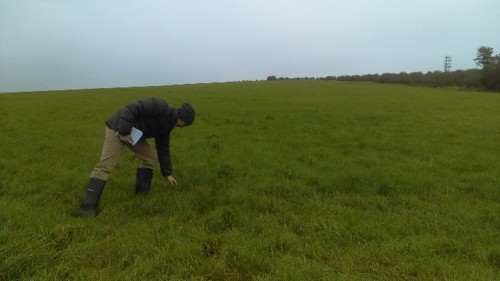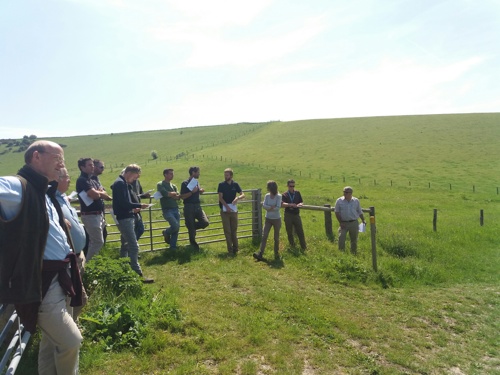

This field lab will investigate the use of a nitrogen-free soil treatment to improve seasonal productivity of chalk grasslands. The aim is to improve livestock gross margins as well as improving the drought resistance of these drought-prone landscapes.
The group will be investigating the benefits of a carbon-rich soil treatment, 'BCP'. BCP is a by-product of biodiesel production from waste materials rather than from crops intentionally grown as biofuel feedstock.
This field lab will have a focus on improving two specific ecosystem services in chalk grasslands:
1) Improved Species Composition, N Fixation and Productivity
2) Driving Improvements in Soil Health and Drought Tolerance.
Gross margins for lowland grazing systems are among the lowest in the farming sector. A lot of work is currently being carried out on arable practices, some work on intensive grazing regimes but very little on extensive grazing systems. It is a significant challenge to those who manage the landscape of the South Downs.
The application of a carbon-rich soil treatment, 'BCP' is expected to increase the abundance of British native N fixing flora, and provide greater N fixation in systems free from manmade fertiliser inputs.
Alongside this, the potential increase in natural water absorbent polymers, or ‘EPS’ (‘Extracellular Polymeric Substances’) also has potential to improve soil health and drought tolerance.
Two liquid C soil treatments (biofuel co-products; BCP) have been selected for their capacity to temporarily immobilise N, owing to their exceptionally high C/N ratio. The first is produced on an industrial scale from waste streams in the UK (comprising mainly glycerol). The second was produced locally from reclaimed chip-fat and is more representative of small-scale biofuel co-operatives, and ‘off-grid’ communities worldwide.
The effects of both treatments will be monitored and compared to control plots (both with and without N applied for quality assurance).
Aerial photos of the 3m x 3m plots show treatment-specific contrasts. ‘Water only’ control plots provide a baseline (pale green), ‘Water + N’ results in predictable greening, ‘BCP’ results in pale green / amber green with temporarily suppressed growth of grass, BCP + N shows deep green and no suppression of growth (serving as a quality control and demonstrating that the differences in greening are due to changes in the availability of N (owing to microbial interactions below the surface).
Click here to view a short video update.
The greening response doesn't provide the full picture; we expect that plots treated with the BCP liquid carbon will be more resilient to drought as the will produce more microbial exudates which hold onto water. We also expect the increase in native nitrogen fixers here - plant species abundance will be assessed later on.
The trial site is located on the thin chalky soils of the South Downs, which are exceptionally drought prone. These soils can serve both as an early warning system for the UK (of climate pressures to come), and as a test-bed for innovative treatments to tackle summer droughts (increasing in frequency as the climate changes).
The final report can be found in the Results and Reports section of the field lab page.
The researcher, Marc Redmile-Gordon, took initial soil samples (29th March 2021), mowed (1st April 2021), and applied the treatments (22nd – 24th April 2021).

The treatments, ‘BCP1’ and ‘BCP2’ have a high carbon (C) content, which stimulate microbial activity in the soil and lead to temporary immobilisation of nitrogen (N). The first (BCP1) was kindly donated by Argent Energy (waste-based biodiesel manufacturer), and applied to the larger experimental area ‘EXP1’. The second, (BCP2) was produced on a domestic/farmer scale and applied to a smaller area ‘EXP2’. BCP2 is a useful backup treatment because it is the same material reported previously in the literature – used to boost soil microbial activity and enabling them to produce water absorbent biopolymers (EPS) suspected to be instrumental for imparting drought-resistance.
The site was split into 6 treatment blocks (enabling one future interacting treatment to be investigated, such as winter N leaching prevention by porous cups) and replicated to increase the statistical power of the trial. Current treatments include:
• EXP1 (24 plots at 9 square metres each):
• Water control (application rate 4.67 L per metre)
• Water + BCP1 (application rate 200 g C per metre; 2 Mg per hectare)
• Water + N control (application rate 18 g N per metre; 180 kg N per hectare)
• Water + BCP1 + N (application rates as above)
Plots arranged with no plot being less than 3 metres from potential upslope runoff.
EXP2 (16 plots at 2 square metres each):
As above, except using BCP2 and N at half application rates.
To test the new sward improvers the group has selected an extensively grazed zero-input pasture at Truleigh Hill which is characteristic of intermediate-diversity parcels on the South Downs. The summers of 2019 and 2020 brought particularly tough challenges on these dry soils: affecting the productivity of the sward, both in this parcel and across the local area.
All the grassland at Truleigh Hill has been managed with zero inputs for 26 years now - currently under stewardship, either HK7 or HK16, and before 2010 the grassland was in ESA (Environmentally Sensitive Area) for 16 years. It is all extensively mixed grazed, with cattle, sheep, and a small herd of Bagot goats as part of a conservation grazing project on the Beeding Hill SSSI to the west. The area the group has selected is part of a parcel of land, managed under an HLS prescription HK7 “restoration of species rich semi natural grassland” since January 2010. It has been extensively grazed by a rotation of cattle and sheep.

In 2019 the site was grazed by a group of 50-60 heifers, followed by c. 200 tegs through the summer months. Existing flora is mixed grassland. Notably red and white clover is spread quite evenly across the area, indicating capacity for N fixing cover to be improved by the treatments. The treatment will be tested for its ability to improve i) legume cover of site-specific provenance, and ii) drought resilience of the sward via interactions it promotes in the soil.
The group is carrying out the final preparations such as procuring materials and quality checking the area and fencing before preparing for mowing in February 2020 (postponed until 2021 due to covid restrictions).
Summer 2019
October 2019
April, June & August 2019
May 2020
June 2020
September 2020

CLM Ltd
South Downs
Farm and Environment Assistant at CLM. Worked as a farmhand on a farm in Buckinghamshire, which was looking to rewild their land. Now helps to facilitate three farmer clusters based in and around the South Downs National Park.
